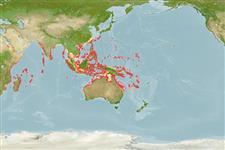Environment: milieu / climate zone / depth range / distribution range
Ekologi
marina revassocierade; ej vandrande; djupintervall 1 - 35 m (Ref. 90102). Tropical; 30°N - 24°S, 114°E - 171°E
Indo-Pacific: East Africa south to Maputo, Mozambique (Ref. 4421) and east to Samoa, north to Ryukyu Islands, south to the southern Great Barrier Reef, New Caledonia, and Tonga. Replaced by Oxymonacanthus halli in the Red Sea.
Size / Vikt / Age
Maturity: Lm ? range ? - ? cm
Max length : 12.0 cm TL hane/ej könsbestämd; (Ref. 9710)
Taggstrålar i ryggfenan (totalt): 2; Mjukstrålar i ryggfenan (totalt): 31-35; Taggstrålar i analfenan 0; Mjukstrålar i analfenan: 29 - 32. Ventral rudiment absent; bristles on caudal peduncle of males longer than others on body (Ref. 37816).
Occurs in clear lagoon and seaward reefs from 0.5 to at least 30 m. Found in pairs or small groups and nests near bases of dead corals, often on clumps of algae. Monogamous (Ref. 52884, 48637). Feeds exclusively on Acropora polyps. Feeding takes place throughout the day becoming less towards the evening (Ref. 46144).
Aggression is used commonly in courtship. Spawning commences when after swimming together in different tufts, the female concentrates on just one and begins to thrust repeatedly and pause. The male follows suit nuzzling the female. The female then drops into the algae and spawns, while the male releases the sperm beside her. The pair then swims back to their territory (Ref. 46144). Monogamous mating is observed as both facultative and social (Ref. 52884).
Myers, R.F., 1991. Micronesian reef fishes. Second Ed. Coral Graphics, Barrigada, Guam. 298 p. (Ref. 1602)
IUCN Red List Status (Ref. 130435)
Threat to humans
Harmless
Human uses
Fiskeri: saknar intresse; Akvarium: Kommersiell
Ytterligare information
referenserVattenbrukVattenbruksprofilAvelslinjerGenetikElectrophoresesÄrftlighetSjukdomarBehandlingNutrientsMass conversion
Verktyg
Special reports
Download XML
Internet-källor
Estimates based on models
Preferred temperature (Ref.
123201): 25 - 29.3, mean 28.4 °C (based on 2439 cells).
Phylogenetic diversity index (Ref.
82804): PD
50 = 0.7500 [Uniqueness, from 0.5 = low to 2.0 = high].
Bayesian length-weight: a=0.01995 (0.00943 - 0.04220), b=2.93 (2.75 - 3.11), in cm total length, based on LWR estimates for this (Sub)family-body shape (Ref.
93245).
Trofisk nivå (Ref.
69278): 3.3 ±0.6 se; based on diet studies.
Resiliens (Ref.
120179): Mellan, lägsta populationsfördubblingstid 1,4-4,4 år (Fec = 200).
Fishing Vulnerability (Ref.
59153): Low vulnerability (10 of 100).
Nutrients (Ref.
124155): Calcium = 79.6 [34.6, 217.9] mg/100g; Iron = 0.822 [0.365, 1.964] mg/100g; Protein = 18.1 [15.8, 20.3] %; Omega3 = 0.121 [0.056, 0.249] g/100g; Selenium = 28.3 [13.4, 65.1] μg/100g; VitaminA = 79.6 [22.6, 288.7] μg/100g; Zinc = 1.51 [0.97, 2.44] mg/100g (wet weight);
